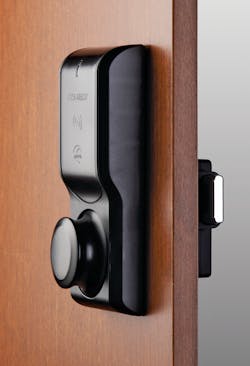Controlling utility/cabinet lock access in a hospital ranges from convenience to required by code. Cabinets hold supplies, medicines, housekeeping and paperwork. Hospitals have medications, bandaging materials, needles, surgical instruments, fixed and portable testing equipment, carts and cabinets. Hospitals store vast quantities of medical records. They maintain a significant amount of patient information. Every hospital must follow the Health Information Privacy (HIPAA) rules.
Sometimes the walls are lined with locked cabinets, which can contain personnel, physician and patient information. Some hospitals offer rentable lockers so new parents and their families secure their personal affects.
Looking beyond the stationary furniture, hospitals have mobile testing equipment, crash carts, phlebotomist carts, and supply carts. Some of these come with factory installed locks, while others have been retrofit by clever locksmiths who fabricate locking mechanisms using electromechanical cabinet locks to secure these mobile cabinet doors or drawers.
Not all equipment has locks. On the crash carts, hasps and tamper-evident seals enable those in charge to know if someone has opened a door or drawer. Tamper-evident seals are usually plastic or plastic metal products that cannot be opened without damaging the seal mechanism.
Applications for mechanical locks include conventional, interchangeable and removable core. Pushbutton mechanical locks eliminate the need for carrying a key. Hospitals have keypad and card reader equipped electromechanical locks; electromechanical locks with audit trail and electromechanical locks with temperature controls and audit trail. These electromechanical locks can provide a higher level of restricted access when they are equipped with a badge reader. Most electromechanical locks at the hospitals I visited were battery operated.
Mechanical Locks
Hospitals have large numbers of mechanical locks offering varying degrees of security and convenience from high security and patent protection to the convenience of utilizing the same key for access control and cabinet lock operation.
Many hospitals prefer pin tumbler locks as they can be master keyed for convenience where permissible. One of the hospitals I visited had five large key cabinets just for utility/cabinet lock key storage. A sampling of lock manufacturers who offer mechanical cabinet locks include ASSA, CCL, CompX and Olympus Lock.
The U.L. 437 Listed ASSA cabinet locks feature the high security 11-pin cylinder that can be keyed into a master key system. CCL offers wafer tumbler, pin tumbler and combination locks for cabinet doors. CompX Chicago and National offer pin tumbler cabinet locks in a wide variety of configurations. Olympus Lock manufactures pin tumbler cabinet locks in a variety of keyways.
CCL and Olympus Lock also manufacture cabinet lock bodies. The CCL bodies are for the Small Format Interchangeable Cores. The Olympus Lock cabinet lock bodies are for conventional lock cylinders, and interchangeable and removable cores, enabling full sized cylindrical keys to operate cabinet locks. Olympus Lock cabinet lock options will accept third party conventional cylinders, Small Format (Best-Falcon), Schlage, Sargent, Corbin Russwin and Medeco Yale Large Format cores. This enables fewer keys with a more complex keying system.
Additional hospital hardware includes office furniture cabinet locks, file cabinet locks, nurse’s stations cabinet locks and specialty locking cabinets. Because of the amount of personal information including patient charts and privacy issues, an almost endless supply of cabinets are locked in locked rooms. A sampling of lock manufacturing companies who offer mechanical pushbutton and/or electromechanical locks are CodeLocks, CompX Security Products, HES, Kaba Ilco, Lockey USA and Medeco.
Kaba Ilco offers two versions of its mechanical pushbutton lock. The Kaba Ilco 9600 Series mechanical pushbutton lock has a single access code that operates a deadbolt/spring latch lock mechanism. The File Guard single access code lock fits standard two- to five-drawer file cabinets. Both locks can be programmed without removing the lock from the cabinet.
The surface-mounted Lockey USA C-170 Cabinet Pushbutton Cam Style Lock is suitable for both indoor and outdoor applications.
Electromechanical Cabinet Locks
Electromechanical cabinet locks can be divided into two basic categories: standalone, battery powered cabinet locks and component-based electromechanical lock mechanisms. Battery powered, 10-digit keypad Codelocks KL100 and KL1200 Cabinet Locks are designed to be installed into a standard cam lock opening. KL Series Cabinet Locks have four programming levels including a one time User Code mode.
CompX offers a variety of standalone battery-operated electromechanical locks including the StealthLock, RegulatoR Lock, Network Cabinet eLock, cabinet eLock, Refrigerator eLock and the Network Temperature Monitoring eLock. The CompX StealthLock is a wireless transmitter pad and battery powered receiver latch. If the transmitter pad is within 15 feet of the receiver latch, the lock mechanism can be unlocked by entering the appropriate code.
Two component-based cabinet locks are available from HES: the HES 660 Series Wired Cabinet Lock and the K100-621Wireless Cabinet Lock. The 660 Series surface-mounted cabinet lock mechanism is wired into an access control system. The 12 or 24VDC 660 Series Cabinet Locks are available with or without the pre-load option that draws from .12 Amps @ 24VDC to .70 Amps @ 12VDC.
The wireless Medeco K100 Aperio Electronic Cabinet Lock eliminates the use of keys and allows entry only to individuals who have authorized HID iClass or Prox card technologies as determined by the access control system. The 250 pound holding force K100 has local wireless communication with the Aperio hub. Once access is permitted, turning the thumbturn retracts the spring latch.
For more information on the companies discussed in this article, contact your local locksmith distributor or the following manufacturers:
ASSA: www.assalock.com/alocks.htm
CCL: www.cclsecurity.com
Codelocks: www.codelocks.us
CompX: www.compxnet.com
HES: www.hesinnovations.com
Kaba Ilco: www.kaba-ilco.com
Lockey USA: www.lockeyusa.com
Medeco: www.medeco.com
Olympus Lock, Inc.: www.olympus-lock.com





